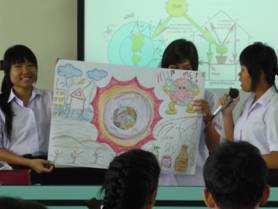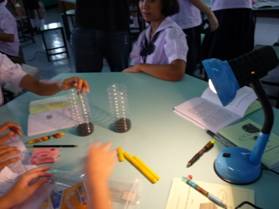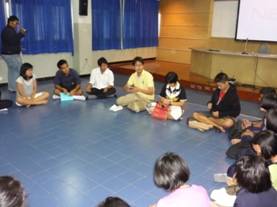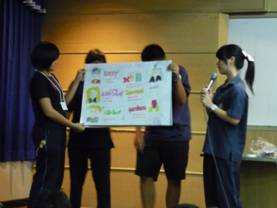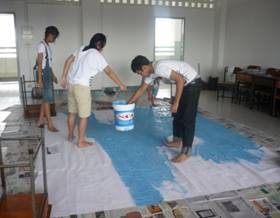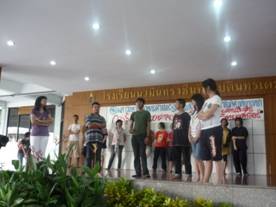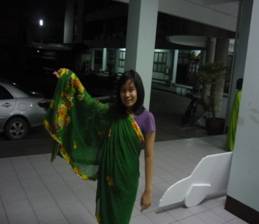Asia-Pacific Forum
on Science Learning and Teaching, Volume 11, Issue 1, Article 4
(Jun., 2010) |
1. Research design
The present paper is a report of the second phase of a two-year research project. The whole project was conducted in an ongoing research and development fashion. It is divided into three phases; Exploration, Implementation and Evaluation, and Extension. In the first phase, semester A, academic year 2008, one hundred and six Grade 7 students from one secondary school in Bangkok completed an open-ended Scientific Literacy Test on Global Warming which had been designed to explore students’ perception, conceptual understanding of global warming and engagement in environmental action. The key findings were taken into consideration in the design of a 7-day process drama workshop that was implemented in the same school during a month break between semester A and B. In the second phase, which is the focus of this report, the effectiveness of the process drama workshop in terms of promoting scientific literacy on global warming was investigated. To disseminate process drama strategy to other teachers of science in charge with educating global warming, in the third phase, the workshop was modified to an intensive professional development workshop. The PD workshop was set up in Nakorn Prathom province during summer. The participants were encouraged to run a drama project in their schools in Semester A, academic year 2009. The researcher followed up these teachers offering assistance and advises on site. He examined how process drama was implemented and its effects on students’ and a community’s level of scientific literacy on global warming.
Critical instance case studies was selected as a research design since it would allow the researcher to be in depth in empirical examination of the selected group of students and teachers of unique interest within its real life context, with little or no interest in generalizability (Yin 1989; Davey, 1991). By this design, the researcher can employ multiple sources of evidence looking an issue from different perspectives for more valid and reliable useful data. This would inform him whether and how dramatic experience promoted scientific literacy on global warming.
2. Participants and setting
There were 31 students participated in the drama workshop; 24 of them were lower secondary students (Year 12-14) and seven of them were high school students (Year 15-17). The drama workshop was initially opened for interested lower secondary students only. However, there were seven high school students who science teachers asked to be included since they had a strong interest in science drama and had been participating in environmental movements. Some of these high school students, mostly girls, were recognized by their teachers as the environmental activists of the school.
The students came from middle and upper class families. Most of the participants lived in the district where school was located; a central district of Bangkok. This district was known as the one facing serious, massive, traffic jams. The major reason for this is the ongoing construction of mega-projects: expressways, tunnels and flyovers, underground metro systems (MRT), and Bus Rapid Transit (BRT). The school is a special large sized public, co-educational, state secondary school with more than 4,000 students. It is fully equipped and still in very good condition. Moreover, the school has been given good and continuous financial support by parents’ association. These funds have been allocated for the benefit of education, welfare and a healthy community within the school. The school has a science self-learning center where the students can have access to numerous science textbooks, magazines, science fiction, posters, and internet. The center is, in addition, equipped with multimedia such as a video player, televisions, and a projector.
To create permanent public awareness about energy conservation, the school implemented a Green Learning Room program with financial support from the Electricity Generating Authority of Thailand (EGAT). The Green Learning Room offers a variety of interactive learning tools to educate school children on the link between energy use and the environment. In addition, the school, at an administrative level, has given importance to environmental issues, especially energy saving. It has run campaigns to raise environmental awareness and concern about global warming for its students. Therefore, the school accepted an invitation to participate and offered support including staffs to assist the researcher running the workshop as an assigned working committee and coordinating with student parents.
3. Research instruments
Multiple data gathering techniques were used: a questionnaire, participant observation, a student journal and a drama script.Their description, development, method of data collection and analysis are detailed below.
3.1. Scientific Literacy Test on Global Warming
The Scientific Literacy Test on Global Warming (SLTGW) is an open-ended questionnaire measuring the level of scientific literacy on global warming. The questionnaire was validated by content experts and piloted with a cohort of 30 junior high school students similar to the target group. The questionnaire consisted of three sections. The first section, Perception of Global Warming, a list of nine key terms related to global warming, was provided asking students if they had heard of some keywords and if so, where from, and how they understood them. The key terms were greenhouse effect, climate change, coral reef bleaching, Kyoto Protocol, biodiesel, gasohol E20, diesel B5, non-renewable energy and renewable energy. The second section, Conception of Global Warming measures their conceptual understanding about the causes, processes, and consequences of global warming. The third section called Engagement against Global Warming; the students were asked whether they had participated in fighting global warming and how they did it. In some questions of the questionnaire, the students were encouraged to draw a picture or a concept map to illustrate their ideas.
SLTGW was distributed to the participants before and after the drama workshop to examine the effect of the dramatic experience on students’ scientific literacy on global warming. It took two hours to complete. Data from the three sections of the questionnaire were analyzed differently. Data from the first section was used to produce frequency of those who had and had never heard the keywords. The definitions of keywords given by the respondents were examined. These were classified into scientifically or non-scientifically consistent. In the second section, responses to each question were carefully read, interpreted and sorted making a list of “big ideas” that represented each of the grouped responses. These ideas were compared with the scientific conception and classified into the following conceptual levels: Sound Understanding (SU), Partial Understanding (PU), Partial Understanding with Specific Misconception (PU&SM), Specific Misconceptions (SM), and No Understanding (N) according to the continuum of conceptual understanding developed by Abraham and Wilkinson (1994). Frequency of students holding a specific level of understanding is calculated. Below is a description of these levels:
• Sound Understanding (SU): Responses that included all components of the validated response;
• Partial Understanding (PU): Responses that included at least one of the components of validated response, but not all the components;
• Partial Understanding with Specific Misconception (PU&SM): Responses that showed understanding of the concept, but also made a statement which demonstrated a misunderstanding;
• Specific Misconceptions (SM): Responses that included illogical or incorrect information;
• No Understanding (N): Repeated the question; contained irrelevant information or an unclear response; left the response blank.
Assigning student ideas to certain levels of conceptual understanding is subjective. To avoid bias, inter-rater reliability was carried out. In doing so, each item, fifty percent of responses were analyzed independently by trained two raters in addition to the researcher. Assigning conceptual label to written response must be agreed by all three raters. In case of disagreement, the raters shared their ideas explaining how they looked at the data and why the response should be labeled that way. The dialogue went on until they reached agreement. The researcher used this framework to analyze the rest of responses. As for the data from the third part, frequency of ways to stop global warming is produced. The results of the questionnaire before and after the workshop from the three sections were then compared.
3.2 Participant observation
The aim of participant observation is to gain a close familiarity with the participants and their practices through an intensive involvement with them during the workshop. This results in detailed and accurate information on how process drama promotes learning. While in the setting, the researcher made careful, objective notes about what he see, recording all accounts and observations as field notes. Informal conversation and interaction with the participants was also recorded in the field notes. All activities in the workshop and students’ performance in a performing day were also videotaped so the researcher could go over the data to make sure that no important points were missed. In addition, the researcher, by the end of each day, had a discussion with training assistants to describe and interpret the events of the day. Content analysis was used to make meaning of observational data. The core questions of content analysis were: "Who says what, to whom, why, to what extent and with what effect on student learning?" In this fashion, the communication content was categorized and classified for building up inferences (Miles & Huberman, 1994; Krippendorf, 2004).
3.3 Student journal
A journal is a continued series of writings made by the participants daily throughout the workshop in response to their dramatic experiences. Every journal entry is individual. It contains a description of daily events, self reflections on what took place and expresses emotions and understanding about them. The data would inform the researcher: how process drama is processed; how it promoted scientific literacy on global warming; and student satisfaction on the teaching strategy. The journal is written at end of a day and handed in the researchers. The researcher also used students’ feedback to guide teaching in the following day. Content analysis is also used to make meaning of student voices in their journals.
3.4 Drama script
A script is the dialogue and action of the drama the participants produced. It contains purpose, circumstances, main characters and their actions. It starts with a general plan and envisions how events unfold. The scripts are the final product of thoughts, values and interpretation. Therefore, it reflected student conceptual understanding of global warming, their concern, environmental responsibility and actions decided to take on the issue. The drama script is analyzed by the following procedure. First, the script is read from the start to the end to get an idea of what the story is about, where it takes place and how the characters behave. The researcher reads the script again and starts making notes about the plot, theme, logic, exposition, main question, action, cause of the action, resulting action, conclusion, and make interpretation.
4. Drama workshop
The intervention encompassed the workshop whose program content was validated by three drama educators who had experience in producing science drama. The workshop aimed to help these inexperienced students make a story and act it out on stage lively. The students are also expected to deliver the correct message about global warming to their audiences. The workshop last for seven consecutive days, October 4th-10th, 2008. Last two days, students stayed overnight at school. The program was divided into two sections; student preparation and drama production and contribution.
4.1 Student preparation
The student preparation, the researcher, taking the shoes of a drama teacher, equipped the students with all needs to produce a drama as discussed previously in theoretical framework section; 1) personal and social ability, 2) performance skills, 3) knowledge and understanding about theatrical ideas and concepts, and 4) theme or the main idea of the play. These elements was rearranged and presented in details in chronological order as follows. As for the personal and social ability focusing on interactive skills, it was embedded in other elements.
4.1.1 Theme or the main idea of the play
The theme of the drama is the science of global warming covering the cause, process, consequences of global warming, raising awareness, concern, and campaigning for taking action against global warming. The research adopted various teaching methods to develop thorough understanding of this message.
4.1.1.1 Doing experiments
As for the science part, the researcher employed scientific inquiry since it is a way we do science. Engaging students in discovery and scientific process improve learning and retention of scientific knowledge. After exchanging their prior knowledge about global warming, the students engaged in a series of laboratories focusing the cause, process, and consequences of global warming (Figure 1). This series was developed by The Queensland Sustainable Energy Industry Development Group, Queensland University of Technology, Australia.
Figure 1: A series of lab exercise about global warming
Students are presenting their existing ideas
Extra CO2 experiment
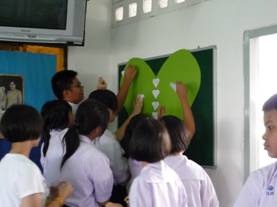
Students are putting up their promise in a heart shape paper on the wall4.1.1.2 Critical reviews of printed media
The students were engaged in a Hard Talk activity. In this activity, broadcast and web-based news about global warming were presented. The students identified purposes and key issues or arguments the writer made, along with important terms, recurring images and interesting ideas and examined how that text portrays the subject matter, questioning the sources that the writer might have used: personal experience, research, imagination, popular culture of the time, historical study, etc. They evaluated the accuracy of the texts, and whether or not they were scientifically based. If not, how it could be corrected was discussed.
4.1.1.3 Watching a video
An Inconvenient Truth, a 2006 documentary film about former United States Vice President Al Gore's campaign to educate citizens about global warming via a comprehensive slide show was presented to the students for further discussion on the cause, effect, consequences and the solutions of global warming.
4.1.2 Performance skills
To be trained to act naturally, the students need to have focus. Vipassana Walking, a Buddhist way of meditation, was applied (Figure 2). When their mind was ready, the students engaged in a series of drama exercises including Mirror, X-men, Emotion, Still Picture, and Yes, And? These were designed to practice their observation skills and quick response, imagination and interpretation, teamwork, and creative thinking.
Figure 2: Acting class
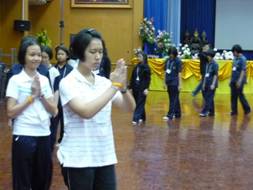
Students are doing meditation
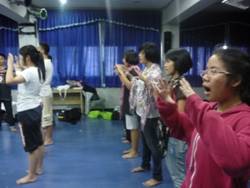
Warm up the throat activity
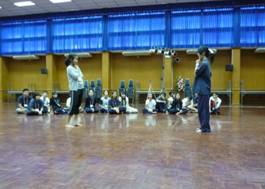
Mirror activity
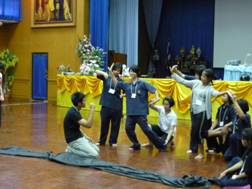
Human puppet show in the still picture activity4.1.3 Knowledge and understanding about theatrical ideas and concepts
There was a session in which the students read a short story and examined how the writer narrated the story (Figure 3). This led to a discussion of the dramatic structure, focused primarily on Gustav Freytag’s analysis (MacEwan, 1900). According to Freytag’s pyramid, a drama is commonly divided into five parts in sequence; exposition (providing the background information needed to properly understanding the story), rising action (complicating basic internal conflict), climax (turning point which marks a change), falling action (unraveling the conflict), and dénouement (concluding). Then the students watched a musical theatre and analyzed the basic elements of theatre (script, scenario, plan; the process; the product; and the audience), most recognizable figures including a director, a playwright, and actors and a production team including scenic designer, lighting designer, costume designer, sound designer, stage manager, props mistress or master and production manager.
Figure 3: Making and developing a story
Analyzing the elements of theare
Students are presenting their story
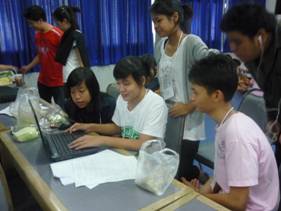
Script writers are developing story and writing a drama script.4.2 Drama production and contribution
They work in group. They were assigned to create a drama story about global warming. The drama should aim at communicating basic scientific information about global warming (cause, process, consequences and cures of global warming) to the public; raising public awareness and environmental responsibility; and entertaining the audience. Five drama stories were written but only one with the highest votes was selected. The winning story was entitled
(in Thai), or “Maybe We Cannot Be Here” (see Appendix). The production teams were formed on a voluntary basis; director, director assistant, playwright, scene, lighting, costume, sound, stage, and props. The team of playwrights established the structure of the drama and overall framework, developed characters, created the dialogue and the visual and environmental elements of the work. The director, director’s assistant, and playwright team act as a casting panel selecting a cast for actors for leading and supporting roles in the scripts. The consideration was based on the photo shoot taken on the first day, self-described personality on the application form, and the observation of their performance from the previous three days of the workshop. They presented a cast list to trainer teams for comments. After revising, the final cast list was announced.
The students went through several rehearsals (Figure 4). These assisted performers in learning dialogue and solidifying aspects of blocking and stage movement; and assisted the production team in technical stagecraft work including constructing and rigging scenery, hanging and focusing of lighting, design and procurement of costumes, makeup, making props, and recording and mixing of sound. The premiere of the drama to the public was on October, 15th, 2008. There were various groups of audience; mainly Grade 9 students, approximately 150 students; about 60 primary students from two schools nearby, the administrative and teaching staff and the students’ parents.
Figure 4: Drama production and distribution
Painting the backdrops
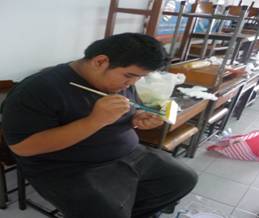
Chum is painting a space gun
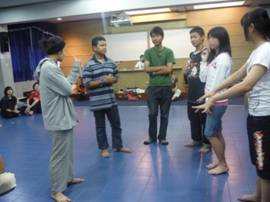
Q2Q rehearsal
Run through
Costume fitting
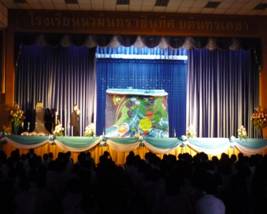
The premiere of the drama

